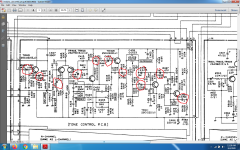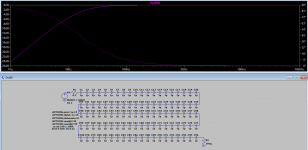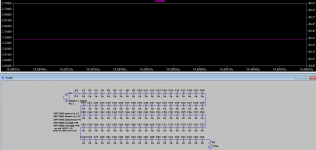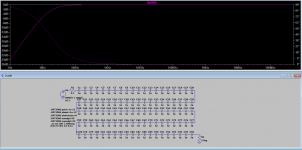It happened 10 years ago when i made a mod to my newly refurbished Realistic STA 2250 .Although the power amp was completely up to date-nichicon muse, ultra low noise and high ft transistors, the eq had way too many electrolitic capacitors in the signal path, actually 11(eleven) 40 years old capacitor , so before changing them i thought of rewiring the tape- monitor switches to be able to bypass the entire tone stack.After doing so and leveling the input output signals, my complete and utter surprise was that i wasn't able to hear anything wrong with the tone eq in.There was somewhat of a different sound, but the differences weren't in favour of removing the tone stack...they were completely irrelevant, like 0.5... 1db out of tune circuit, but nothing to criticise .From that point on to these days i simply disregarded any claim of a better sound due to dc coupling.
Attachments
Last edited:
I have done similar comparisons in the past with similar results. I used to have bunch of rather good cassette decks, and was listening to the signal coming to the tape deck and coming out, adjusting bias and level to match both signals as closely as possible. Sometimes on a good tape I achieved no signal difference what so ever, which means dozens of capacitors in signal path.
Main problem is that they age.
Main problem is that they age.
Totally agreed. Just remember how many electrolytics the audio signal has to pass in the mixing consoles before being put on vinyl or on CD. If those capacitor rolling afficionados were right, not too much useful were to be expected on a vinyl or CD copy.
Note: If you don't know of them, you won't hear them.
Best regards!
Note: If you don't know of them, you won't hear them.
Best regards!
Rooms perform major phase shifts on music waveforms. We listen to music in rooms. We are used to the effect. Fairly random with multiple sources.
Capacitors only do a predictable phase shift up to 90 degrees based on frequency. Each. No nasty echoes or standing waves.
I have a capacitor in capacitor out amp, an AX6. I have another amp with direct out that can be direct in from one of the source jacks, a Peavey CS800s. At the same volume on my SP2-XT speakers, I can't tell them apart. The fan is quieter on the CS800s. The CS800s would have more headroom with 6x the wattage, but CD's only have 70 db of signal/noise, and most don't have nearly that much dynamic range.
The CS800s protects the $600 (new) speaker from DC out with a $40 replacement cost relay per channel, and a microprocessor it would cost me an $800 up to date PC and $200 in software to program, plus program skills I don't have and don't want to learn. The whole software business makes everything obsolete every year, update update update, bleah. The AX6 protects the speaker from DC with a $3 capacitor.
Capacitors only do a predictable phase shift up to 90 degrees based on frequency. Each. No nasty echoes or standing waves.
I have a capacitor in capacitor out amp, an AX6. I have another amp with direct out that can be direct in from one of the source jacks, a Peavey CS800s. At the same volume on my SP2-XT speakers, I can't tell them apart. The fan is quieter on the CS800s. The CS800s would have more headroom with 6x the wattage, but CD's only have 70 db of signal/noise, and most don't have nearly that much dynamic range.
The CS800s protects the $600 (new) speaker from DC out with a $40 replacement cost relay per channel, and a microprocessor it would cost me an $800 up to date PC and $200 in software to program, plus program skills I don't have and don't want to learn. The whole software business makes everything obsolete every year, update update update, bleah. The AX6 protects the speaker from DC with a $3 capacitor.
Last edited:
" The AX6 protects the speaker from DC with a $3 capacitor."
in the last years i change almost any power amp i can to virtual ground topology placing the cold wire of the speaker or headphone in between a bunch of series capacitors.If enough capacitors are placed in parallel you have no audible badwidth or distortion problems. QSC were the first to do it at a a very large scale with their very high power amplifiers and they never changed that as it's a genious idea.
in the last years i change almost any power amp i can to virtual ground topology placing the cold wire of the speaker or headphone in between a bunch of series capacitors.If enough capacitors are placed in parallel you have no audible badwidth or distortion problems. QSC were the first to do it at a a very large scale with their very high power amplifiers and they never changed that as it's a genious idea.
Last edited:
You (theoretically) can't hear distortion below 0.1%, so if any distortion is below that then what does it matter, especially if it is a magnitude (0.01% or less) below this level. Trying to achieve very low distortion for audio use, like your standard hi-fi setup with a source and amplifier which might have a couple of gain stages, seems like a waste of time.
I wonder how many series capacitors you would need to really hear a difference...
I wonder how many series capacitors you would need to really hear a difference...
I wonder how many series capacitors you would need to really hear a difference...
it depends on the circuit/transducer impedances.... In valve head amps world there were amps using like 10 series switched capacitors to affect the tone as the imput impedances with valves are very high.
it depends on the circuit/transducer impedances.... In valve head amps world there were amps using like 10 series switched capacitors to affect the tone as the imput impedances with valves are very high.
True, but I mean for example, take a low impedance output preamplifier, and a high impedance input power amplifier, choose an electrolytic (or other) capacitor value so that they have no effect on bandwidth, and then how many would you need.
Could I replace a 2 meter length of cable between the two with a string of 50 capacitors and not hear a difference...
Could I replace a 2 meter length of cable between the two with a string of 50 capacitors and not hear a difference...
if you have 0.1 ohm output Z preamp to 10 megohms amp input impedance you can probably place 2 meters of series 1uf capacitors and barely be able to hear differences... but i'd look to have very low dc voltage specifications on very low tan losses capacitors too like fkp1 63v caps if possible cause the thicker the dielectric the higher the losses.The other problem is the noise you pick with 2 meter of capacitors...
Last edited:
Actually there's be some low frequency drop off, lets say 100 caps in series, so 10nF
into 1M load, -3dB at 15Hz. 50 capacitors and this would be less, and the voltages across
each capacitor are in the milli- to micro-volt region so typical non-linearities would be too low to measure.
Some snakeoil seller is designing a capacitor-string interconnect as we speak !!
into 1M load, -3dB at 15Hz. 50 capacitors and this would be less, and the voltages across
each capacitor are in the milli- to micro-volt region so typical non-linearities would be too low to measure.
Some snakeoil seller is designing a capacitor-string interconnect as we speak !!
"Some snakeoil seller is designing a capacitor-string interconnect as we speak !!"
They even made the simulation for it . It looks like 100 caps in series are the best subsonic filter for the most exquisite phono preamp already
They even made the simulation for it . It looks like 100 caps in series are the best subsonic filter for the most exquisite phono preamp already
Attachments
Last edited:
There was somewhat of a different sound, but the differences weren't in favour of removing the tone stack...they were completely irrelevant, like 0.5... 1db out of tune circuit...
The above statement appears self-contradictory. That fact that you actually heard a difference seems potentially quite relevant.
The above statement appears self-contradictory. That fact that you actually heard a difference seems potentially quite relevant.
Last edited:
Totally agreed. Just remember how many electrolytics the audio signal has to pass in the mixing consoles before being put on vinyl or on CD. If those capacitor rolling afficionados were right, not too much useful were to be expected on a vinyl or CD copy.
Note: If you don't know of them, you won't hear them.
Best regards!
And just imaging how nice it might be to be without them - will we ever know
//
- Status
- This old topic is closed. If you want to reopen this topic, contact a moderator using the "Report Post" button.
- Home
- Source & Line
- Analog Line Level
- Behold the circuit that destroyed my preconception on capacitor induced distortions



